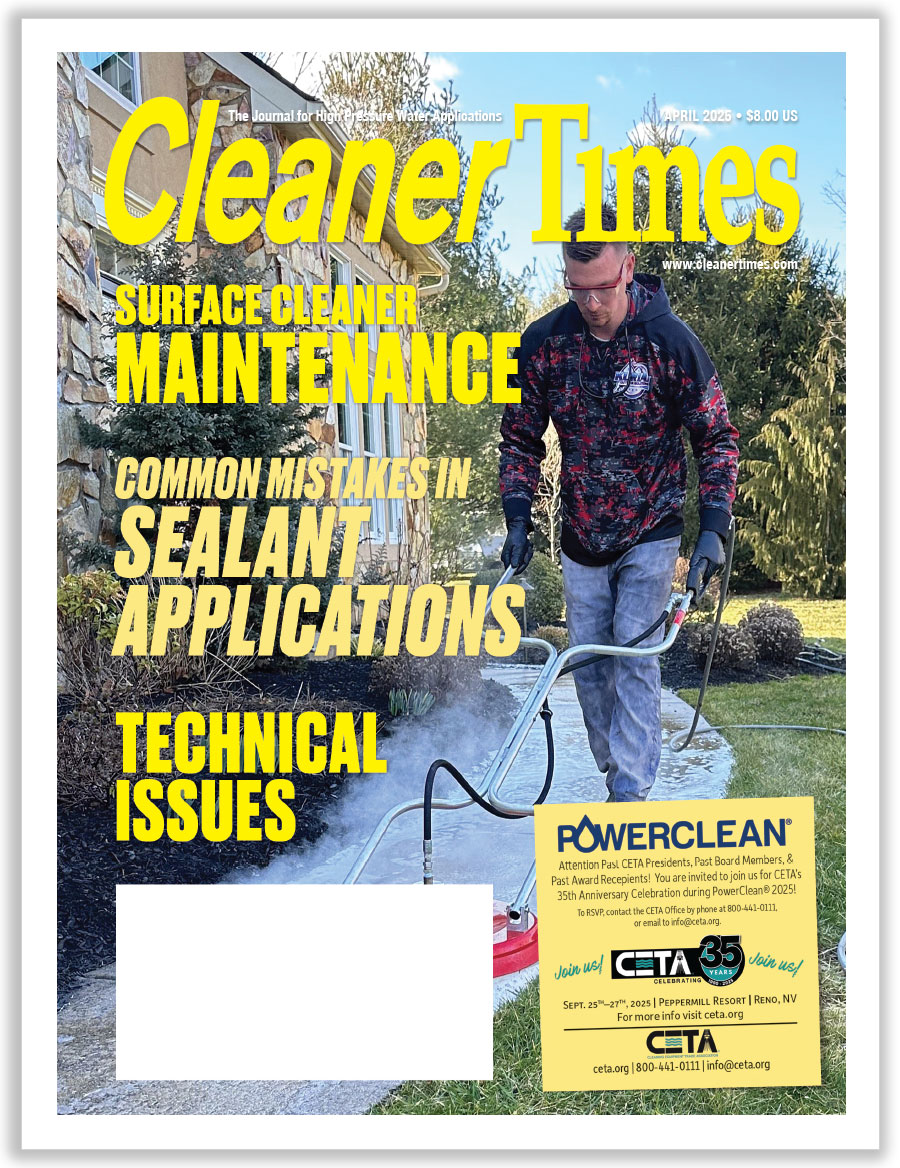
Financial
Independent Contractors
By Mark E. Battersby / Published February 2021

It may be time for those calling themselves independent contractors to rethink that label, and for the pressure washing businesses that use them to take a closer look at their status. Although much has been written about the advantages and disadvantages for both workers and businesses based on how a worker is classified, controversy continues about who is and isn’t truly “independent.”
Those pressure cleaning businesses utilizing independent contractors to minimize payroll tax costs and headaches have long battled the IRS and other government agencies over who is and who isn’t an independent contractor. Obviously, being labeled as an employee can have a profound impact on everything from overtime pay to fringe benefits and, of course, taxes.
The Fast-Spreading California Definition
A California law, Assembly Bill 5 (AB5, effective January 2020) imposed significant restrictions on independent contractors. Intended to force businesses to hire freelance workers as employees with health care and other benefits typically afforded to full-time employees, AB5 is now a reality.
California’s AB5 forced millions of independent workers to choose between becoming a full-time worker or not to work at all. AB5 also restricted the ability of business owners to employ them, causing many to suffer.
Dozens of politically connected professions have successfully lobbied for exemptions and California voters recently approved Proposition 22, exempting Uber, Lyft, and other ridesharing and delivery providers from having to reclassify their drivers as employees.
While AB5 doesn’t specifically exempt pressure cleaning professionals, it does provide a definition of independent contractors, a definition that is reportedly being considered by several other states. The three-part ABC test created by AB5 defines a worker as an employee unless the worker:
- Is free from the control and direction of the hiring entity in connection with the performance of the work,
- Performs work outside the usual course of the hiring entity’s business, and
- Customarily engages in an independently established trade, occupation, or business of the same nature as the work performed.
Why Independent?
Since the U.S. Supreme Court’s decision almost 60 years ago, employers and workers have been forced to navigate the often-divergent opinions of the lower courts, the rules of the IRS, the Department of Labor and other government agencies, federal and state, battling those who believe that most workers should be treated as employees, not as an independent contractor.
For years, businesses have avoided the responsibilities and costs of being an employer by using independent contractors. Independent contractors, for the most part have been happy with the flexibility provided by their status despite the lack of company-provided benefits.
Under our federal tax law, independent contractors are self-employed individuals who are responsible for their own tax filings and payments. Independent contractors pay both income and self-employment taxes on their earnings.
Employers are required to withhold income taxes from the wages of their workers along with Social Security and FUTA (unemployment) taxes from employees. Employees will receive Forms W-2 from their employer showing wages and withholdings for the year.
The IRS
The IRS announced at the beginning of 2020, instead of reporting compensation for independent contractors on Form 1099-MISC, Miscellaneous Income, they’ve resurrected Form 1099-NEC, Nonemployee Compensation, which is still to be used in 2021. This will, presumably, allow the IRS to better track independent contractors and the businesses treating them as such.
Fortunately, the IRS has a form, Form SS-8, that either workers or an employer can fill out to obtain an IRS determination on worker status. Although the IRS’s SS-8 program is helpful, there is some risk involved. According to the IRS, in fact, 72 percent of all Form SS-8 requests it received resulted in IRS determinations that the workers in question were employees.
Surprisingly, about 90 percent of Form SS-8 requests are filed by workers, which could explain the skewed numbers. Obviously, employers should be taking advantage of this process more frequently, notwithstanding the figures.
The Department of Labor (DOL)
Because the minimum wage and overtime protections of the Fair Labor Standards Act (FLSA) do not extend to independent contractors, the DOL has long been required to decide whether someone is an employee or an independent contractor. According to the DOL, even if someone is an independent contractor under another law, they may still be considered an employee under FLSA.
The DOL’s Wage and Hour Division (WHD) recently proposed new regulations for determining whether a worker is an employee or an independent contractor under FLSA. Under the proposal, status would be determined by the economic reality of the relationship and by asking whether workers are economically dependent on a putative employer for work, as distinguished from being in business for themselves.
The primary focus would be on two core factors—the nature and degree of workers’ control over the work, such as by setting their work schedule, selecting projects, and being able to work for others; and workers’ opportunity for profit and loss based on their own initiative, investment, or both.
Other factors, including the required skill level for the work and the permanence of the working relationship, would be given less weight. And, the parties’ actual practice would be more relevant to the DOL’s labeling than what may be contractually or theoretically possible.
The National Labor Relations Board (NLRB)
Because independent contractors do not have a protected right under the National Labor Relations Act to form unions, the NLRB must sometimes decide whether workers are independent contractors or employees. The NLRB recently revised its 2014 classification test, emphasizing the importance of evaluating whether a worker has entrepreneurial opportunity for gain or loss in determining independent contractor status.
The basic principle from the 2014 classification test remains, however; namely, that the more control the business exerts on a worker, the more likely the worker should be treated as an employee.
The Coronavirus Pandemic Conundrum
In an effort to help all of those impacted by the pandemic, the CARES Act took the unprecedented step of including independent contractors in the group of “workers” eligible to apply for both federal and state aid. By some accounts this means lawmakers have tacitly admitted that gig workers are not really so independent. In fact, they apparently feel there is little difference between them and displaced workers who lost their jobs.
This fundamental change in the government’s attitude towards gig workers and other independent contractors may have opened the door to additional codification of the independent contractor rules. If both employees and independent contractors can receive unemployment when they lose their jobs, aren’t they really the same?
The Bottom Line
Independent contractors must pay and report both the employee and the employer portion of employment taxes. Plus, the pay-as-you-go nature of the federal tax system means independent contractors may have to make quarterly estimated tax payments to prepay their tax liability.
Unlike employees who can no longer deduct their employment expenses, independent contractors can deduct many work-related costs. Naturally, this requires good records. How are expenses treated for tax purposes?
Employees
- Out-of-pocket expenses are no longer deductible under current tax law;
- An employer may, of course, reimburse work-related expenses tax-free with an accountable plan.
Independent Contractors
- Ordinary and necessary business expenses are usually deductible and can include the following:
- Materials, tools, supplies, and uniforms;
- Health insurance premiums;
- Home office expenses;
- The portion of the cell phone bill attributable to business use;
- Vehicle expenses, either actual or the current flat per-mile standard deduction.
The 2017 Tax Cuts and Jobs Act (TCJA) made independent contractor status more desirable for workers, especially high-income workers, than it ever was for business owners. Switching from employee to independent contractor status can mean a tax cut of between $12,500 and $24,000 annually for high income workers—even considering the worker’s payment of the business’s former half of the Social Security and Medicare (FICA) taxes.
The pressure washing business that hires an independent contractor, rather than an employee, receives the financial benefit of not being required to pay its half of FICA taxes. The business also does not have to pay any employee benefits to anyone correctly labeled as an independent contractor.
Whether paid directly to an employee, an independent contractor, or a gig platform, a pressure cleaning business usually incurs a tax-deductible expense. Naturally, amounts paid to employees require additional payments of payroll taxes and the headaches associated with withholding the employee’s payroll taxes and payments of fringe benefits. Recipients of those funds must, of course, report those amounts as income.
The Government Accountability Office estimates that worker misclassification costs the federal government $2.7 billion per year, while both the IRS and the U.S. Department of Labor (DOL) believe that up to 30 percent of employers are misclassifying workers. Unfortunately, there is no uniform test to distinguish employees from independent contractors.
Government agencies such as the IRS, the DOL, and the NLRB each use their own guidelines to define independent contractors. And, as illustrated by California’s AB5, Proposition 22, the same may be true in the state where the pressure cleaning business is located. Professional assistance may be needed by all parties involved.






